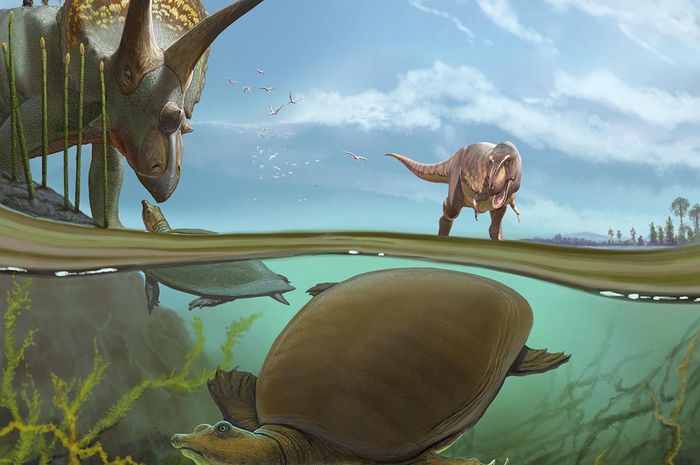Sergey Krasovskiy
–
Hutchemys walkerorum lived more than 66 million years ago.
–
Nationalgeographic.co.id—A team of scientists from the University of Pennsylvania report describing a luna shell turtle that lived in North Dakota 66.5 million years ago at the end of the Cretaceous Period. The tortoise is known to have lived just before mass extinction in the late Cretaceous, making it one of the earliest species of the genus.
Scientists named the turtle Hutchemys walkerorum. The species name walkerorum honors Greg and Susan Walker, whose philanthropy created the ‘The Greg and Susan Walker Endowment’ program in 2006. Thanks to that, students in the Department of Earth and Environmental Sciences (EES) can apply for funding to undertake research projects for unsourced other funding.
Hutchemys walkerorum known to have lived during the late Cretaceous period, when dinosaur large and famous also roamed the Earth, including Tyrannosaurus rex and Triceratops. Details of the research have been published in the journal Cretaceous Research online under the title “A softshell turtle (Testudines: Trionychidae: Plastomeninae) from the uppermost Cretaceous (Maastrichtian) Hell Creek Formation, North Dakota, USA, with implications for the evolutionary relationships of plastomenines and other trionychids“.
The findings add important information to scientists’ understanding of softshell turtles more broadly. Including the potential effects of the late Cretaceous mass extinction, which occurred during the same time period, on their evolution.
Steven Jasinski, who recently completed his Ph.D. in Penn’s Department of Earth and Environmental Sciences at the School of Arts & Sciences, leads research, in collaboration with advisors Peter Dodson from the School of Veterinary Medicine and Penn Arts & Sciences. The research team included Andrew Heckert and Ciara Sailar of Appalachian State University, Asher Lichtig and Spencer Lucas of the New Mexico Museum of Natural History and Science.
Hutchemys walkerorum belongs to a certain group of soft shell turtles in the family Trionychidae called plastomenin. These turtles are similar to the soft shell turtles that exist today. Although the plastron of the plastomenine tortoise, the bones that cover its abdomen and ventral region, is more firmly stitched together and is often larger and sturdier than other soft shell turtles.

Science Photo Library
–
Hutchemys walkerorum survived a mass extinction event
–
Plastomenin lived during the Cretaceous and Paleogene periods, about 80 million to 50 million years ago. Members of this group first appear in the fossil record during the Late Cretaceous. And one species continued into the Eocene Period, 50 million years ago, but they were at their peak diversity before and after the Cretaceous-Paleogene boundary.
“Until now we didn’t understand these softshell turtles very well. However, we are starting to get more information about this extinct group of turtles and better understand their evolution, including how they faced mass extinctions,” Jasinski said in the release. University of Pennsylvania.
A fossil specimen of a new species, part of the carapace, spine-covering bone and what people think of as turtle “shell”, was discovered in 1975 in southwest North Dakota. Appalachian State University field crew led by Frank K. McKinney and John E. Callahan collected the specimen, along with the Triceratops specimen, that summer. The fossilized turtle specimen remained in the Appalachian State until 2013.
PROMOTED CONTENT
Featured Videos
–

/data/photo/2020/02/19/5e4d2b5aa66df.jpg)
